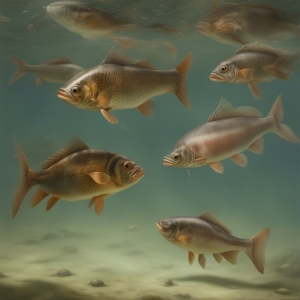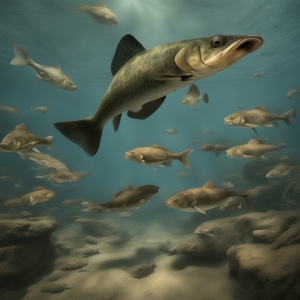Table of Contents:
Introduction to Catfish Fishing
Stepping into the world of fishing can feel like learning a whole new language. There are various types of fish to catch and methods to learn. But, if there's one type that both beginners and veterans can enjoy, it's catfish fishing. A popular pastime, fishing for catfish is thrilling and rewarding. Whether you're planning a casual day out or an intense fishing expedition, knowing the basics can improve your success.
From understanding the best baits and rigs to learning how to reel in the big ones, we're here to guide you through the essentials of catfish fishing. This comprehensive guide is designed to make your catfish fishing experience smoother and more enjoyable. So, join us as we dive into this exciting topic and discover the key components you need for your next catfish fishing adventure!
Choosing the Right Bait for Catfish
The first step in a successful catfish fishing trip is choosing the right bait. Catfish are known for their strong sense of smell, which they use to track down their food. Hence, using stinky baits is the norm when targeting these fascinating creatures. Staples in the catfishing world include chicken liver, cut bait, shrimp, and a variety of specialty catfish baits you can purchase at your local fishing store.
An important factor to consider when choosing the bait is the type of catfish you're trying to catch. Each species has specific preferences. For instance, Channel Catfish love strongly scented baits like chicken liver while Blue Catfish prefer fresh cut bait. In contrast, Flathead Catfish are more attracted to live baits. Understanding the species you are fishing for will greatly help in selecting the most enticing bait.
Bait presentation is also crucial when targeting catfish. To ensure your bait is attractive and accessible, consider using a rig that best suits your chosen bait and the specific species of catfish you are pursuing. Fishing for catfish isn't only about casting your line out and waiting, it also involves formulating a plan based on the species' feeding habits and environment.
Pros and Cons of Catfish Fishing Techniques
| Technique | Pros | Cons |
|---|---|---|
| Using baits | Economical, Easy to use, Effective | Some baits may not attract catfish, Can be messy |
| Using rigs | Allows for deeper fishing, Can handle big catch | May require specific knowledge, Can be expensive |
| Landing big ones | Highly rewarding, Potentially large catch | Requires patience, Risk of gear damage |
How to Rig for Catfish

The next piece of the puzzle after selecting the right bait is setting up your rig. The rig you use can drastically affect your catfish fishing success rate. The most commonly used rigs for catfish fishing are the sliding sinker rig, also known as the Carolina rig, and the three-way rig. Both rigs are effective and have their advantages depending on the fishing situation.
The Carolina Rig is known for its simplicity and effectiveness. It involves a sinker that slides on your mainline, improving sensitivity so you can feel even the slightest nibble. It's a classic choice for most bottom-feeding fish like catfish. This rig works best in waters with minimal structure on the bottom, allowing your bait to float above any potential snags.
On the other hand, the three-way rig uses a three-way swivel to connect a shorter line with a heavy sinker and a longer line with your bait. This rig keeps your bait elevated from the bottom, ideal for fishing in areas with much underwater structure or vegetation, to prevent snagging.
Keep in mind that different conditions and catfish species might require adjustments in your rig setup. The type of bait you use, the depth of water, and the underwater terrain are all factors to consider when setting up your rig. Experimentation and a little bit of trial and error can often lead to the most effective rig for your specific catfish fishing situation.
Landing Big Catfish: Techniques and Tips
After having mastered the art of choosing the right bait and rigs for catfish, it's time for the highlight - landing big catfish. These bottom-dwellers are known for their size and strength, presenting an exciting challenge to passionate anglers. Indeed, landing a big catfish involves leveraging a combination of skill, technique, and patience.
Firstly, it's important to make sure your gear is up to the task. For these robust fish, a medium-heavy to heavy rod is often recommended. You'll want a rod that's strong enough to handle the weight, yet flexible enough to absorb the catfish's energetic fight.
Once you feel that telltale tug on your line, the trick is to produce a solid hookset. Catfish have tough mouths, so ensuring the hook is securely in place is crucial. When you're sure the catfish has taken your bait, give a firm and swift upwards pull to set the hook.
The fight, however, is far from over. The real challenge comes when trying to reel in a big catfish. Catfish are noted for their vigorous fights once hooked, capable of powerful runs and stubborn resistance. Start reeling in, while keeping the rod tip raised to maintain tension. If the fish runs, let it, but continue to keep pressure.
Lastly, while adrenaline might be pumping, remember to be patient and maintain endurance. Winning the catfish fight often requires a steady, persistent reeling approach. It might take time, but the rush of landing a big catfish is worth every minute.
That said, targeting large catfish is not just about the thrill. It also encourages us to respect the energy and prowess of these amazing creatures. Practice catch and release to ensure these giants continue to thrive in their aquatic homes!
Understanding Catfish Behavior

If you're looking to increase your chances of a successful catch, it's essential to understand the behavior of catfish. Catfish are opportunistic feeders, meaning they will typically eat whatever is available, but their activity levels and feeding habits can change depending on a range of factors.
It is essential to know that catfish are overwhelmingly nocturnal creatures. They tend to be most active during cooler, overcast days or during the night. For the angler, this means that fishing in the early morning or late evening can often yield the best results.
Temperature plays a big role in catfish activity. Like all fish, catfish are cold-blooded, meaning their body temperature and activity levels are influenced by the surrounding water temperature. Catfish become more active in warmer water conditions, and consequently, their feeding behavior increases during the warmer months of the year.
Another aspect of catfish behavior is their love for structure. Catfish love to inhabit areas with object cover like fallen trees, rock piles, or underwater vegetation. Keep this in mind when choosing your fishing spot as these areas often serve as great hiding spots for catfish and ideal spots for angling.
Finally, a general understanding of their food preference and hunting strategy can make a lot of difference. Catfish rely on their exceptional sense of smell and taste, they can detect prey even in turbid or murky waters. Remember, while fishing for catish, your goal is to mimic the prey that the catfish is naturally inclined to pursue.
Conclusion: The Art of Catfish Fishing
Catfish fishing is indeed an art, weaving together knowledge of the species, skill in choosing the right bait and rig, and finally, the mastery of techniques to successfully land these majestic creatures. However, this art becomes more rewarding and enjoyable with experience. So, don't get discouraged if the 'big one' gets away on your first few tries.
Instead, learn from it and continue to hone your skills. Remember, fishing is not just about the catch; it's about the journey too. The harmony of nature, the thrill of the chase, and the satisfaction of a well-executed trip can be just as fulfilling as actually landing a catfish.
In the end, understanding the catfish, employing the right tools, and mastering the techniques are only a part of the puzzle. The ultimate secret to becoming a successful angler lies in your patience, passion for the sport, and desire to learn. As you embark on your catfish fishing adventures, we hope that this guide proves to be an invaluable companion, supporting you on your journey to master the art of catfish fishing.
Your Complete Guide to Catfish Fishing

What is the best bait for catfish?
Some of the most effective baits for catfish include cut bait, live bait, and stink bait. However, the best bait often depends on the catfish species you are targeting.
How to rig for catfish?
There are several different methods to rig for catfish, including the slip sinker rig, the bobber rig, and the three-way rig. Each has its own advantages and is suited to different fishing conditions.
How to land a big catfish?
To land a big catfish, you need the right gear including a sturdy rod and heavy-duty line. Make sure your drag is set properly and be patient. The fight can be long and exhausting.
What is the best time to catch catfish?
While catfish can be caught year-round, the best time is typically in the warmer months. Night fishing can also be especially fruitful for catfish, as they are often more active during cooler, darker periods.
Where is the best place to fish for catfish?
The best place to fish for catfish depends on the species. Generally, catfish are found in freshwater environments. This can include everything from small ponds to large rivers or reservoirs.







